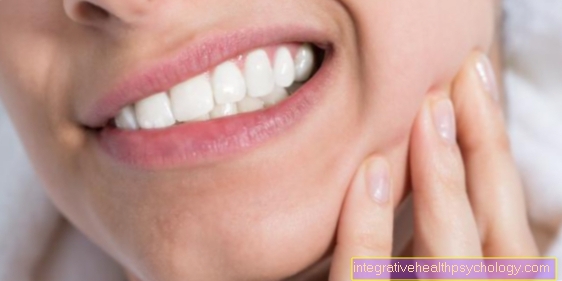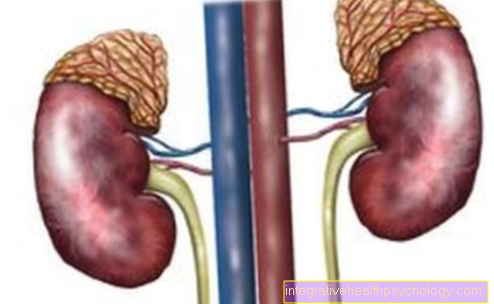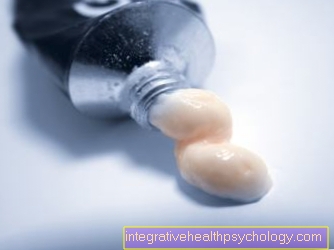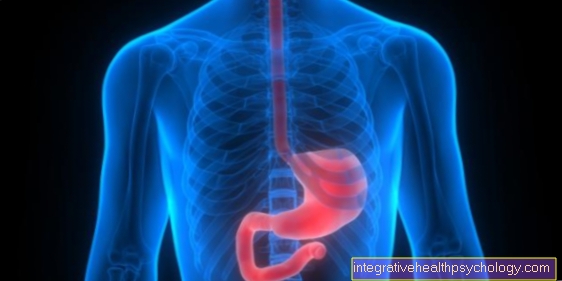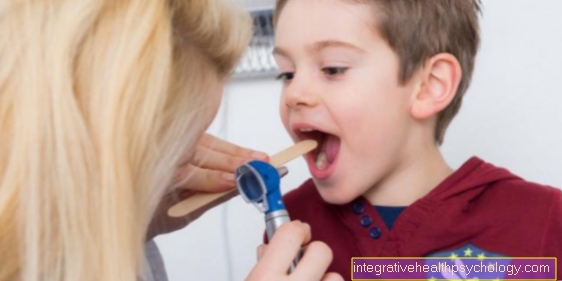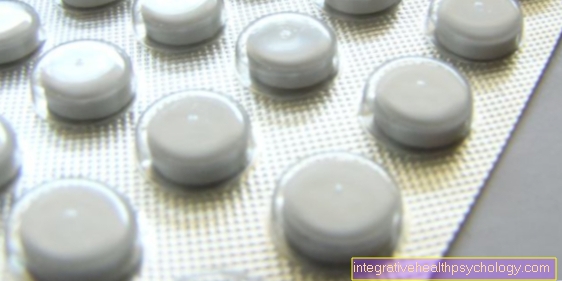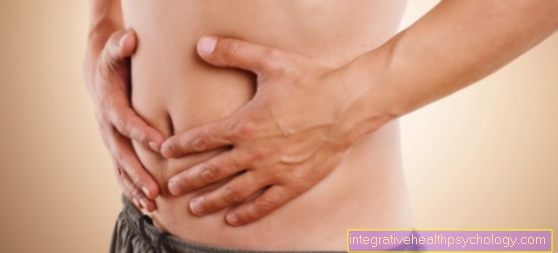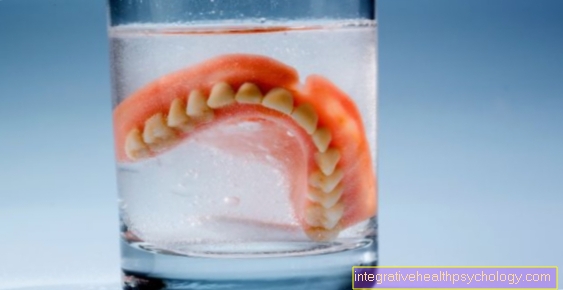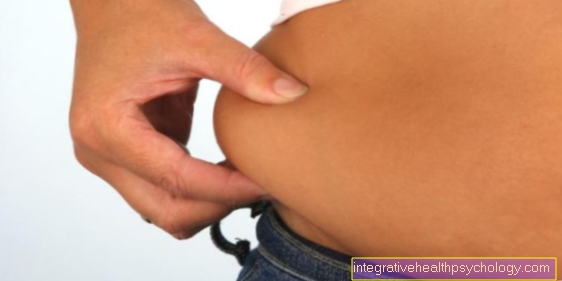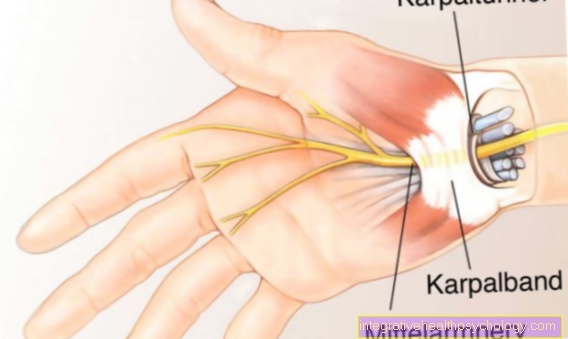Mouth rot in the baby
introduction
Mouth rot in babies is caused by herpes viruses just like in adults. It is a highly contagious disease that affects the oral mucosa and forms small blisters and ulcers there. After the vesicles burst, white-yellowish wounds appear, which are very painful.
This open wound healing causes the very typical, putrid smell in babies. The disease is often associated with fatigue and loss of appetite, due to the pain that occurs when touching the blisters.
You might also be interested in this topic: Baby herpes - how dangerous is it?

Symptoms
Just like adults, babies and toddlers have the very typical symptoms of mouth rot. The difference, however, is that these are much more pronounced in the little ones.
- At the beginning of the disease, after unspecific attacks of fever, the typical whitish-yellow vesicles form, which burst after a few days. These are mainly found on the tongue, palate and gums, while the rest of the oral mucosa is reddened and burns heavily.
- After the blisters have burst and released their secretion, reddish ulcers remain, which can crust over time. The flow of saliva is increased and food intake is often refused.
- Furthermore, the babies develop a very unpleasant, sour, sometimes putrid bad breath.
- Externally, the cervical lymph nodes may be swollen and painful to the touch.
- But general symptoms also appear: exhaustion and an increased tendency to scream are often associated with additional infections of the respiratory tract.
If your baby suffers from the typical symptoms, the way to the doctor should take place directly so that an exact diagnosis can be made and the therapy is not unnecessarily prolonged.
Learn more about the topic at: Mouth rot in children / toddlers
Symptoms on the tongue
In addition to the typical blisters that appear all over the mouth, there are other symptoms on the tongue. The papillae of the tongue, on which the taste buds are located, become inflamed and small white dots can be seen on the tongue. This causes very strong, burning pains, which above all make it difficult or even impossible to eat. Liquid foods that are as cold as possible are still bearable and can be consumed.
causes
The herpes virus can always be identified as the cause of mouth rot in babies. Herpes simplex virus 1 (HSV1) in particular comes into consideration here, and herpes simplex virus 2 is much less common. The virus is transmitted via saliva through direct contact with the infected person. The spread of the virus is immense as it is highly contagious. However, the disease does not manifest itself in everyone.
Read more on the topic: Herpes Simplex Virus
In the majority of cases, the infection with the virus is asymptomatic and there are no symptoms whatsoever. The outbreak of oral rot is therefore - in relation to the virus carriers - rather the exception. Mouth rot is very common in schools and kindergartens. The reason for this is that the disease is the first manifestation of the virus and children in particular become infected with it when they eat together or use playground equipment.
How long is the incubation period?
The incubation period is the time between contact with the herpes virus and the onset of the disease. This is a very individual time, which differs from child to child and is also related to the physical condition and the strength of the immune system. However, the first blisters appear on average within 1-26 days and thus trigger the typical pain. The virus remains in the body after initial contact and can break out repeatedly as a cold sore in adulthood.
Further information can also be found at Course of the mouth rot.
How contagious is mouth rot in babies?
Mouth rot can spread very quickly, especially among small children and babies. One of the reasons for this is that the affected little ones put all their toys in their mouths and then pass them on to their playmates without hesitation. This direct type of transmission means that the daycare center is absolutely taboo until all the blisters are dry and the children should stay at home - preferably in bed.
You should avoid contact with the child's saliva and limit the kiss on the mouth for the duration of the acute illness. Otherwise the virus can be transmitted to other children or the partner very quickly.
Read more on the topic: Contagion with mouth rot
Path of infection by oral rot
It is indeed very difficult to prevent oral rot, as the virus can spread via both smear and droplet infections. Since almost everyone carries this virus, contact for babies is inevitable. About 80% of the 2-year-old children have already developed antibodies against the herpes virus, although not all of them have lived through the mouth rot in its entirety. Contact with other children who are acutely suffering from oral rot should therefore be avoided at all costs. The little ones' toys would only have to be put in their mouths once and exchanged, and the disease would be transmitted.
How dangerous can mouth rot be in babies?
As a rule, the herpes virus is a rather harmless contemporary. The disease becomes problematic, however, when it affects unborn or very young babies around 8-10 weeks of age. During this period, the immune system has not developed sufficiently to keep the virus weak. Damage to the eyes, skin or even microcephaly (head that is too small) are the result, as the virus spreads systematically.
Newborns struggle with the infection for up to six weeks and can be very weak during this time despite medication. You drink little and vomit frequently. Since inflammation can then also spread in the brain, it is essential to intervene and administer an antidote.
diagnosis
The diagnosis of "mouth rot" is primarily a visual diagnosis. The doctor is familiar with the typical signs and symptoms of this disease and knows exactly that this type of blister is related to oral rot. However, since there are other blister-like diseases of the oral mucosa, a laboratory analysis is carried out in uncertain cases. For this you need some saliva, which is cultivated and assessed under the microscope. After the final diagnosis, the doctor can initiate the appropriate therapy.
Which doctor treats mouth rot?
If the baby suffers from oral rot, one should see a pediatrician. Drug treatment is only indicated in exceptional cases when the oral rot is particularly severe. First, an attempt is made to lower the fever by taking paracetamol. The pain can be relieved by using a numbing gel or cream. Furthermore, the doctor will prescribe bed rest and ask not to meet friends until they have healed, otherwise they can easily become infected. In many cases, the symptoms can also be alleviated by home remedies and the healing of the disease can be made relatively pleasant.
Course of mouth rot in the baby
After infection, the disease begins to spread within a maximum of 26 days with a general feeling of illness and fever. Initially, the gums swell, but there is no pain yet. Next, the insides of the cheeks become inflamed and small whitish-yellow vesicles form on the roof of the mouth, tongue and gums. These aphoid-like structures burst open over time, releasing an extremely contagious liquid.
Whitish ulcers develop, slowly and painfully encrusting the mucous membrane and sometimes pus forming. In this phase, eating and drinking hurts very badly and the little ones don't want to eat anything. This can be very dangerous. Sometimes the pain can even be so severe that fluids can no longer be supplied and the children have to be given water via infusions. The pain only gets better after about 2-3 weeks, when the blisters slowly dry out and everything heals. After infection, there is immunity to oral rot. However, the viruses remain in the body for a lifetime and can become active again at a later point in time.
Read more on the topic: Course of the mouth rot
therapy
In addition to the home remedies for mouth rot described below, medication can also be prescribed by a doctor. This is absolutely necessary, especially with very young babies, as otherwise it can spread to the eyes or even into the brain. Basically, therapy begins with treating the symptoms. Attempts are made to lower the fever while also relieving the pain. Paracetamol works very well here, as it combines both effects.
The pain can be relieved locally with various gels and creams. These contain a surface anesthetic and superficially numb the tongue, palate and cheek. There are also sprays that contain the drug chlorhexidine. This has a disinfectant effect and can kill viruses and other bacteria. In the case of very severe courses, an antivirus is used. It is acyclovir, which accelerates healing.
Homeopathy for mouth rot
Since all homeopathic remedies need some time to take effect, the administration of the remedies should be started as early as the first symptoms.
- Belladonna D12, an extract from deadly nightshade, is used against the fever.
- Borax can help with virus-related changes in the mucous membrane. It is mainly used for acute acne and herpes and the D6 potency.
- Lachesis D12 is particularly effective against pain when the symptoms occur relatively far back in the throat.
- Lycopodium, which is obtained from a moss-like plant, ensures better wound healing. Here it is above all the antibacterial effect of the aluminum ions contained in it that ensures rapid healing.
Which home remedies help against mouth rot in babies?
There are many different home remedies that can be used to cure mouth rot. Not all of them are suitable for treating babies and young children because of their ingredients. The medicinal plants chamomile and sage are particularly good because they have a disinfectant and anti-inflammatory effect. A boiled tea bag should be placed on the sore spots for a few moments so that it can take effect locally.
There are also tinctures of these two plants or tea tree oil, which are applied locally to the affected areas with a cotton swab. Even if honey and sugar are otherwise forbidden in babies' teas in order not to cause tooth decay, this additive can be very effective in this case. The honey has a strengthening effect on the immune system and can thus accelerate healing.
Cold in the form of ice cubes also brings a lot of relief. If you put these on the wounds, the pain will improve and the little ones will cry less. All other known home remedies are much more difficult to use because they are used in the form of mouthwashes. However, this form of application is not possible in babies, as they are more likely to be swallowed than spit out.
Read more on the topic: Home remedies for mouth rot
Does my baby need antibiotics?
Since mouth rot is a viral infection, antibiotics are not prescribed in this case. These remedies would have no effect here. Rather, an antiviral substance called acyclovir helps at this point. This medication can speed up the healing process, but it is not always used. The doctor makes a very individual decision, depending on the type of complaints, the course of the disease and the general condition of the baby. However, you should start as early as possible if the course is severe.
Duration of mouth rot
In addition to the individual constitution of the baby, which plays a major role in healing, there is a certain time frame in which the disease takes place. In the course of the incubation period, there are attacks of fever, which can last about 4-5 days. During this time, the gums slowly begin to swell without pain.
Subsequently, after the first 5 days, the typical vesicles form, which are mainly located on the palate, tongue and gums. After these have broken open, ulcers develop, which dry out and heal over time. The duration of this course depends on the severity of the infection and is around 1-3 weeks until complete rehabilitation. It is important that regular check-ups with the doctor take place during these weeks so that the virus cannot spread further unnoticed. Otherwise, you have to act quickly and prescribe an antiviral agent such as acyclovir.
Also read: Duration of mouth rot
When can my child go back to daycare?
Since oral rot is a highly contagious disease, you should not visit the KiTa until the little ones are no longer contagious. Only when the blisters have healed completely should the babies have contact with their peers again, otherwise there is a risk of infecting the other child. The first contact with the virus is problematic, as this is the only way to develop oral rot. When reinfected, the virus spreads in the lip and shows up as a common cold sore.




